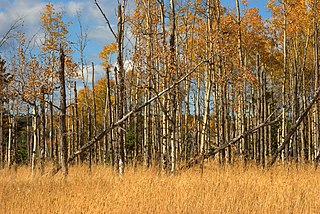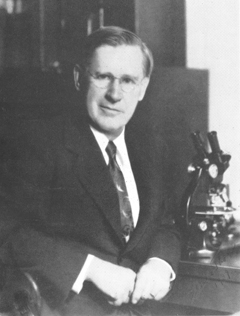
Penicillium is a genus of ascomycetous fungi that is part of the mycobiome of many species and is of major importance in the natural environment, in food spoilage, and in food and drug production.
Penicillium bilaiae is a species of native soil fungus that can be used as a PGPM. R. Kucey first identified that organic acids excreted by the microorganism can solubilize soil-bound phosphate. The organism can live in symbiosis with several plant species by enhancing phosphate uptake by the root structure while feeding off plant waste products. Native soil populations are often low and can be increased by application as an agricultural inoculant.

The Trichocomaceae are a family of fungi in the order Eurotiales. Taxa are saprobes with aggressive colonization strategies, adaptable to extreme environmental conditions. Family members are cosmopolitan in distribution, ubiquitous in soil, and common associates of decaying plant and food material.

Aspen parkland refers to a very large area of transitional biome between prairie and boreal forest in two sections, namely the Peace River Country of northwestern Alberta crossing the border into British Columbia, and a much larger area stretching from central Alberta, all across central Saskatchewan to south central Manitoba and continuing into small parts of the US states of Minnesota and North Dakota. Aspen parkland consists of groves of aspen, poplar and spruce, interspersed with areas of prairie grasslands, also intersected by large stream and river valleys lined with aspen-spruce forests and dense shrubbery. This is the largest boreal-grassland transition zone in the world and is a zone of constant competition and tension as prairie and woodlands struggle to overtake each other within the parkland.

Penicillium roqueforti is a common saprotrophic fungus in the genus Penicillium. Widespread in nature, it can be isolated from soil, decaying organic matter, and plants.

Antarctica is one of the most physically and chemically extreme terrestrial environments to be inhabited by lifeforms. The largest plants are mosses, and the largest animals that do not leave the continent are a few species of insects.

Charles Thom was an American microbiologist and mycologist. Born and raised in Illinois, he received his PhD from the University of Missouri, the first such degree awarded by that institution. He studied the microbiology of dairy products and soil fungi, and in particular researched the genera Aspergillus and Penicillium. His work influenced the establishment of standards for food handling and processing in the USA. He pioneered the use of culture media to grow microorganisms, and, with food chemist James N. Currie, developed a process to mass-produce citric acid using Aspergillus. Thom played an important role in the development of penicillin in World War II.
Penicillium albidum is an anamorph fungus species of the genus of Penicillium which was isolated from volcanic soils in the south of Chile. Penicillium albidum produces the antibiotic Albidin.
Penicillium vanoranjei is an orange-colored fungus first described in 2013 from specimens collected in Tunisia. It was named after the Prince of Orange Willem-Alexander to commemorate his coronation as King of the Netherlands.
Penicillium calidicanium is a fungus species of the genus of Penicillium which was isolated from soil in Taiwan.
Penicillium chermesinum is an anamorph fungus species of the genus of Penicillium which was isolated from soil from Nova Scotia in Canada.Penicillium chermesinum produces plastatin, luteosporin, xanthomegnin, azaphilones, p-terphenyls and costaclavine.
Penicillium nodositatum is an anamorph, biverticillate species of the genus Penicillium which induce the growth of the myconodules in the species Alnus incana.
Penicillium scabrosum is a species of fungus in the genus Penicillium. Described as new to science in 1990, it was first isolated from soil associated with corn in Denmark. It has also been found in soil samples from other temperate areas of the world, including Canada. The fungus is a spoilage organism for foods, particularly those with lipid- and cereal-containing feed. It produces several mycotoxins, including fumagillin, viridicatin, and viridicatol. P. scabrosum is classified in Penicillium subgenus Penicillium, section Divaricatum, series Atroveneta.
Penicillium parvum is an anamorph species of fungus in the genus Penicillium which was isolated from soil in Papua New Guinea. Penicillium parvum produces ferrichrome siderophores
Penicillium pimiteouiense is a species of fungus in the genus Penicillium which was isolated from sandy beach soil from the Penang Island in Peninsular Malaysia.
Penicillium purpurescens is a species of fungus in the genus Penicillium which was isolated from soil in Canada. This species is similar to Penicillium glabrum. Penicillium purpurescens produces hadacidin.
Penicillium smithii is a species of fungus in the genus Penicillium which produces citreoviridin and canescin Penicillium smithii occurs in soil in Canada and Europe
Penicillium vancouverense is a species of fungus in the genus Penicillium which was isolated from soil under a maple tree in Vancouver in Canada.

Penicillium spinulosum is a non-branched, fast-growing fungus with a swelling at the terminal of the stipe (vesiculate) in the genus Penicillium. P. spinulosum is able to grow and reproduce in environment with low temperature and low water availability, and is known to be acidotolerant. P. spinulosum is ubiquitously distributed, and can often be isolated from soil. Each individual strain of P. spinulosum differs from others in their colony morphology, including colony texture, amount of sporulation and roughness of conidia and conidiophores.






